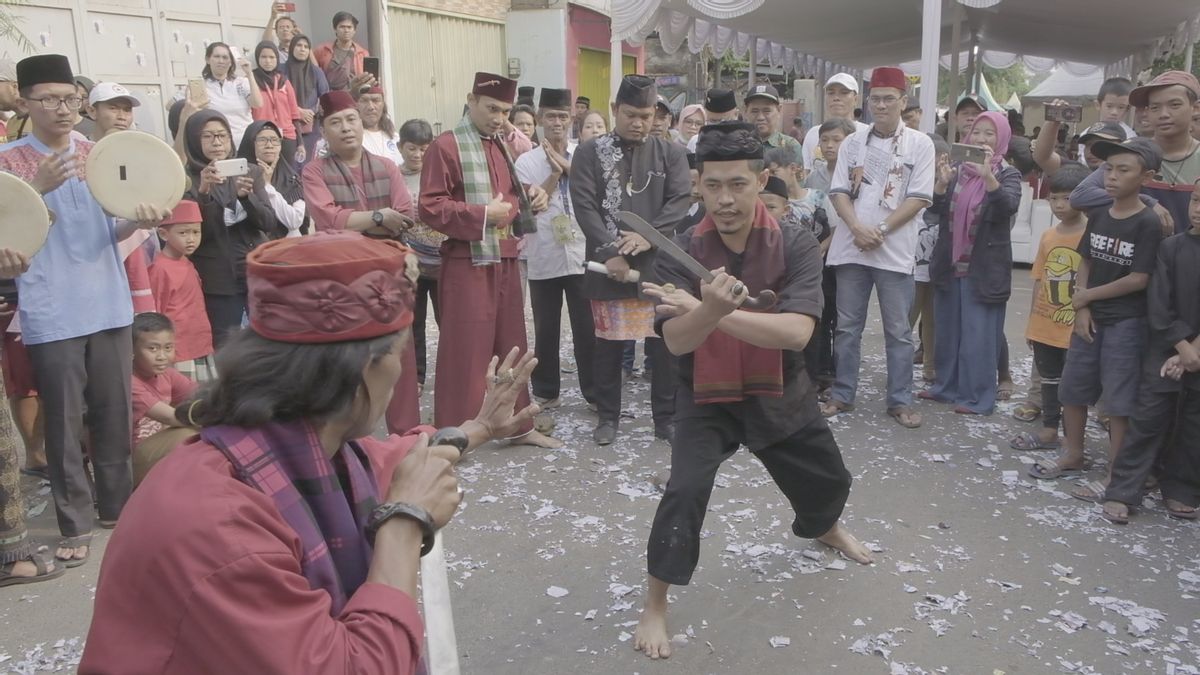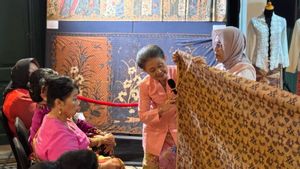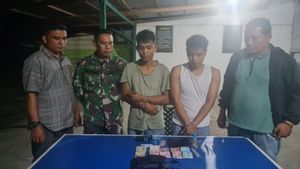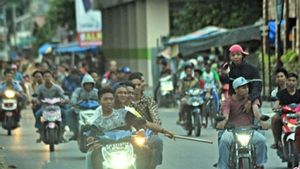JAKARTA -
"A mustache as thick as a bahar root on the arm, dark red eyes, just like the garnish of blood on the fingers. A gun from Nica's booty and a machete tucked either side of the waist, which is wrapped in an invulnerable belt."
Zeffry Alkatiri's poem entitled Mat Item
That is the figure of Mat Item described by Zeffry Alkatiri in his book From Batavia to Jakarta, 1619-1999 (2001). The figure of Mat Item as a person who has immunity and is good at martial arts, of course, has the magic of traditional weapons that are always on the right and left of the waist, especially if it's not a machete.
In fact, it's not just Mat Item. The legends of Betawi silat masters, starting from Si Pitung, Si Jampang, and Entong Gendut, always fortify themselves with machetes. The most obvious picture can be seen from the film Si Pitung, Banteng Betawi (1971) which was successful in the market.
The figure of Pitung, played by Dicky Zulkarnaen, is able to provide an image to the public regarding the dashing and handsome looks of a Pitung who always looks like a typical Betawi champion.
His appearance, ranging from yellow or cream trousers, a colored cap jacket, a gauze, a black cap or headband, a leg with a blade, and a machete inserted at the waist covered by the coat, became his main characteristics.
In line with Si Pitung, another good figure who always appears with a machete is Si Angkri who is the champion of the Fish Market. Written by Rahmat Ali in a book entitled Betawi Folklore Volume 1 (1993). Si Angkri, who is described as a hero who is greatly feared by the population in every food stall in the Fish Market, because he never pays for having a meal, also has the same appearance as the other heroes.
“They are always dressed all in black, with headbands and sleeves with bahar roots. On their fingers perched several large agate rings. They always slip a machete on their waist, ”said Rahmat Ali.
Even so, the influence of the Golok as a stabbing tool is not only described as belonging to the Jago. Margreet Van Till in his book entitled Batavia Kala Malam: Police, Bandits and Firearms (2006), reveals that the machete is also a weapon used by ordinary people who rebelled against arbitrary treatment by the landlords of the Company era, such as in Tambun and Ciomas.
Every rebellion that erupts, always tells the story that they used a machete as a weapon or it could be the only weapon against injustice. "In the Rebellion in Tambun in 1869 it was clearly stated that the rebels only had machetes, without firearms," said Margreet.
Similar conditions were shown in the rebellion that was most talked about in Ciomas in 1888. The rebellion in Ciomas was similar to what happened in Tambun, partly because most rebels relied on the traditional weapon of the Golok as a means of struggle apart from injustice.
“The difference in power between rebels and colonial power-bearers is still more heartbreaking. At that time (Ciomas rebellion) 75 helpless men were shot from the top of a cliff. In such an uprising there were no firearms seen among the population, ”he wrote.

Betawi Golok
According to G. J Nawi, the author of the book Maen Pukul: Pencak Silat Khas Betawi (2016). Golok is considered a sharp weapon that is generally found in Malay society with different names in each region. So that most people on the island of Java call 'Bacok' type weapons as machetes.
Over time, thanks to the popularity of the Golok in Batavia (Jakarta) which was often used by Jago since the Company era, it gave birth to a popular expression among children and adults that reads "not a Betawi man, if you don't have a Golok."
Regarding the type of Golok itself. GJ Nawi said that the Betawi golok were divided into two groups, namely the Gablongan Golok and the Sorenan Golok. “Golok gablongan is a tool that is usually used for daily work, such as cutting wood and trees. There are also those who call it bendo or kitchen machete. Meanwhile, the sorenan golok is only used from time to time, for purposes other than daily work. "
"The sorenan cleaver can be divided into two. One is named Golok Sorenan Simpenan for slaughtering animals (goats, buffalo, and cows) and the other, Golok Sorenan Waist for self-defense or fighting, which is always tucked into the waist, ”said GJ Nawi.
In line with that Betawi cultural observer who is also the leader of Silat Beksi in Setu Ciganjur village, Rohmat S considers the golok not only a stabbing tool, but he considers the golok as a sacred weapon that cannot be shown, let alone played carelessly in public.
"Golok is not just an ordinary sharp object, because if you pay attention, there is also a beauty and a philosophy that is not inferior to other heirlooms, such as kris."
How could it not that in every anatomy of the Golok there is a deep meaning "The handle of the machete symbolizes the handle of life, the sharp blade is interpreted as a symbol of courage, and the sarong is interpreted as being covered by religion and belief," said a cultural observer who is familiarly called Bang Omat when contacted by VOI, April 6th.
Therefore, it is natural that as an heirloom weapon, the Golok is passed down from generation to generation in the Betawi community. The reason is, as a protective device that can be used at any time if there is a problem and there is no word of peace. There, someone who is born with Betawi blood, simply shows the handle of the machete tilted, as a sign that he is ready to fight.
The Betawi young figure Masykur Isnan also revealed the sacredness of Golok, who was contacted by VOI some time ago. He revealed that as a young Betawi, two things must be identical. "The first is good at reciting (studying religion) and good at martial arts (traditional Betawi silat)."
"This means that since we were little we have been accustomed to getting to know the Golok, where every time we finish the Koran, we immediately continue to learn silat, including playing the Golok, which is necessary for a fighter to learn how to use moves, especially with the Golok." Close Masykur Isnan.
The English, Chinese, Japanese, Arabic, and French versions are automatically generated by the AI. So there may still be inaccuracies in translating, please always see Indonesian as our main language. (system supported by DigitalSiber.id)









